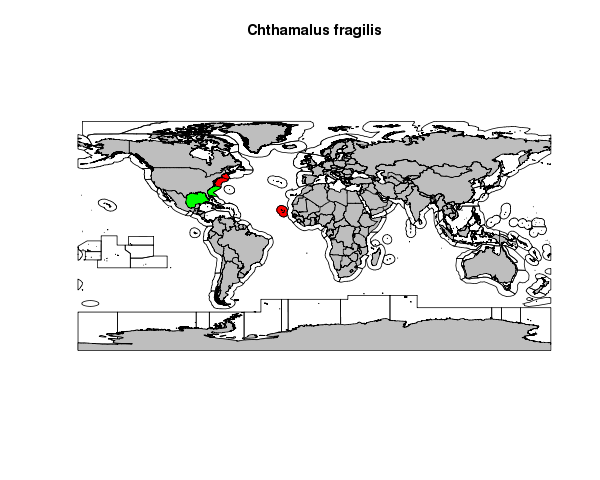Habitat
Barnacles are interesting organisms that require a
specific habitat in order to survive.
In general, barnacles
exist in salt-water environments or marine locations. Within
those environments, Chthamalidae tend to live in the intertidal
zone and specific locations can depend on competition. With
their glue-like substance, barnacles can also be found attached
to hard surfaces. (Fofonoff
PW, Ruiz GM, Steves B, & Carlton JT 2003) These surfaces
can range from rocks and woody debris, to ship hulls, and
animals like turtles and whales.
Although native to the Eastern coast of North America,
Chthamalus fragilis is now also found in other locations such as the
Gulf of Mexico and the Cape Verde Islands. Starting off, this
organism was first discovered in Charleston, South Carolina, but
then they later found in parts of Florida, New Jersey, Rhode Island,
Massachusetts and Connecticut. (Fofonoff
PW, Ruiz GM, Steves B, & Carlton JT 2003)
Chthamalus fragilis has
migrated and continued to expand its geographical habitat. Because
of attachment to ships and other moving substrates, the migration of
Chthamalus fragilis can
continue as long as a suitable habitat is found.
Within marine environments, this barnacle is found in
intertidal locations, more specifically,
Chthamalus fragilis live
in the upper intertidal zone.
C. fragilis is found just above the genus of barnacle,
Semibalanus, which live a
layer below them. (Fofonoff
PW, Ruiz GM, Steves B, & Carlton JT 2003)
Like other species, the geographic location of
Chthamalus fragilis can be
determined by its competition. Competition with
C. fragilis was explored
relative to location, and it was found that
C. fragilis was more
abundant in places their competition—Semibalanus
balanoides—was unable to live due to their own
temperature restrictions. (Wethey, D.S. 2002) Because of the
tolerance to higher temperatures,
Chthamalus fragilis can be
found just southern of Cape Cod.
Like other barnacles,
Chthamalus fragilis attach themselves to hard substrates. In
general, this barnacle attaches itself to rocks, ship hulls, woody
debris, and docks. C. fragilis is an “acorn barnacle” which happens to develop straight
onto a substrate, therefore serving as a permanent home.
In general, Chthamalus
fragilis has continued move around the world to different
locations and areas. With different ways of migration, the movement
of this particular barnacle is not limited and has potential to
continue. Therefore, further research is able to be conducted on the
location and migration of this organism.
Fofonoff PW, G.M. Ruiz, B. Steves, & J.T. Carlton. 2003.
National
exotic marine and estuarine species information system. <URL:
http://invasions.si.edu/nemesis/>.
Accessed
3 Mar 2014
Dougherty, W.J. 1990. Barnacle adhesion:
reattachment of the adult barnacle
Chthamalus fragilis Darwin to polystyrene surfaces followed by
centrifugational shearing. Journal of Crustacean Biology 10:469-478
Wethey, D.S. 2002. Biogeography,
competition, and microclimate: the barnacle
Cthamalus fragilis in New
England. Integrative and comparative biology. P. 872-880
Sturm, C.F. Pearce,
T.A. and
Valdés, A. 2006. The Mollusks: A Guide to Their Study, Collection,
and Preservation. Universal Publishers, Boca Raton, Florida
learner.org 2003.
Journey North <URL:
http://www.learner.org/jnorth/tm/Barnacle.html>.
Accessed 25 March 2013
Home | Classification | Adaptation | Nutrition | Reproduction | Interactions | Facts |

